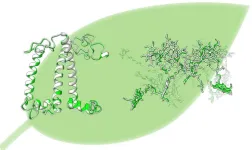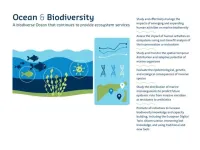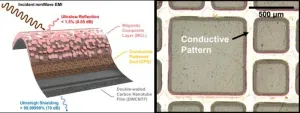(Press-News.org) Researchers at UCLA Health have found that a person's risk of developing psychotic-like experiences may be influenced by both childhood attention problems and their genetic makeup.
The findings, published in Nature Mental Health, build upon a long-studied association between childhood attention problems and the likelihood of later developing schizophrenia. Using data from about 10,000 children over six years, UCLA researchers led by Dr. Carrie Bearden sought to determine how attentional variability influenced the risk of broader psychotic-like symptoms as children grow into adolescence.
Specifically, the team looked at how the youths’ risk for psychotic-like experiences varied based on their attention span and genetic variants that may predispose them to different neuropsychiatric conditions.
The researchers found:
A higher genetic risk for a broad set of neuropsychiatric and cognitive disorders was associated with greater severity of psychotic like experiences and greater attention issues.
Additionally, attention span variability partially acted as an intermediate between the relationships between genetic risk for neuropsychiatric disorders and the expression of psychotic-like symptoms. Attention span issues explained 4-16% of these associations.
“If attention completely explained the relationship between genetic predisposition and psychotic-like experiences, that percentage would be 100%,” said study co-first author Sarah Chang, a neuroscience graduate student at the UCLA Health Semel Institute for Neuroscience and Human Behavior. “While there are many risk factors for psychosis, the mechanisms through which these risk factors operate, particularly during this developmental risk period for psychosis, are not well understood - and that's where our paper comes in.”
“We have known for a very long time that attention problems are some the earliest precursors of psychosis,” said Bearden, a professor at the UCLA Health Semel Institute and the UCLA Health Brain Research Institute. “Taking a different approach of looking at this large, typically developing youth cohort we find a really strong association with broad neurodevelopmental risk that was most strongly linked to psychotic symptoms. Attentional variability appears to be a mediator that links the genetic liability and those symptoms.”
While the majority of youth who experience psychotic-like symptoms will not go on to develop schizophrenia, these events do increase the likelihood for future psychotic disorders and mental illness. Bearden said the findings help researchers to better understand the relationships from the genomic to behavioral levels during the critical stage of early adolescent development, which may lead to future molecular targets that could be targets for early intervention for psychosis.
Continued evaluation of the study participants through time will be critical in helping to determine the most predictive factors of schizophrenia diagnosis and neuropsychiatric outcomes.
“If you have this strong liability based on your genetics and early attentional span, we don't know what the longer-term trajectories are and who are the people who are going to be more resilient to their underlying risk,” Bearden said. “That's going to be really important to look at when those data become available.”
The study used cognitive, brain and genetic data from more than 10,000 participants in the ongoing Adolescent Brain and Cognitive Development (ABCD) study. The study, led by a national consortium of research institutes including UCLA Health, is examining brain development in nearly 12,000 youth starting at age 9 and followed over the next decade into their early adulthood.
An important part of Bearden’s study involved the use of polygenic scores for neuropsychiatric conditions. Unlike some neurological conditions such as Huntington’s disease which is caused by alteration to a single gene, there are often hundreds or even thousands of genetic variants associated with psychiatric disorders. Polygenic scores are used to summarize the combined effect of a large number of genetic variants to estimate a person’s risk for developing the disorder.
Bearden and her team used polygenic scores for schizophrenia and neurodevelopmental disorders derived from existing large datasets and applied them to the dataset from ABCD study participants.
A limitation of using the polygenic scores currently available is that they mostly rely on genetic data from people with European ancestry, which limits the study’s applicability to people of non-European backgrounds, Bearden said. Advancements in genetic studies being carried out in other areas of the world will help to remedy these limitations, Bearden said.
“In a few years we will have much better polygenic scores. That will be a really huge advance,” Bearden said.
END
Childhood attention issues and genetic factors may predict psychosis risk
UCLA Health researchers find inconsistent attention span acts as a “middleman” that connects genetic influences to early psychotic symptoms
2024-10-28
ELSE PRESS RELEASES FROM THIS DATE:
Amsterdam UMC study proves impact of rapid first shock after cardiac arrest
2024-10-28
It is well known that acting quickly in the event of a cardiac arrest is important, but what does a quick initial shock with a defibrillator mean exactly for patients' chances of survival? Researchers from Amsterdam UMC analysed the data of 3723 patients who had a cardiac arrest outside the hospital and concluded that for the first shock, every minute reduces the chance of survival by 6%. The results of this research were published today in the international journal Circulation.
"Our research shows that every minute of delay in giving the first shock has a major impact. If the first shock was given within six minutes, it was possible ...
Children’s BMI can affect their future lung function
2024-10-28
An abnormal BMI in children – be it high or low – can now be associated with impaired lung function, but if their BMI is normalised before they reach adulthood, the impairment can be offset, researchers from Karolinska Institutet report. Their results, which are based on data collected under the BAMSE project in Sweden, are presented in The European Respiratory Journal.
One in ten people have reduced lung function development in childhood and cannot achieve maximal lung capacity in adulthood, increasing the risk of serious health problems such as cardiovascular disease, lung disease and diabetes. One risk factor associated with impaired lung function development is abnormal ...
Don't worry. Study shows you're likely a more creative writer than ChatGPT. For now
2024-10-28
Imagine you decide to write a short story about a protagonist who creates an artificial human and then falls in love with it. What gender is your protagonist? What about the artificial human? Would you write a moving love story? A cautionary dystopian tale?
Would your story be more compelling than one written by ChatGPT?
Likely yes, says Nina Beguš, a researcher and lecturer in UC Berkeley's School of Information and Department of History. Leveraging her background in comparative literature ...
Heart failure mortality declining in Sweden
2024-10-28
A new study from Karolinska Institutet shows that heart failure mortality has decreased in Sweden over the last 20 years. The study has been published in the European Journal of Heart Failure.
A national study has shown that heart failure mortality has decreased in Sweden over the last two decades. Despite these improvements, the prognosis for heart failure patients remains worrying – 25 percent of those diagnosed in 2022 died within a year.
“Our results suggest that advances in heart failure treatment over the past decades have reduced heart failure mortality, both at the population level and for individual patients. ...
Understanding how mutations affect diseases
2024-10-28
Many statistical models and algorithms used by scientists can be imagined as a “black box.” These models are powerful tools that give accurate predictions, but their internal workings are not easily interpretable or understood. In an era dominated by deep learning, where an ever-increasing amount of data can be processed, Natália Ružičková, a physicist and PhD student at the Institute of Science and Technology Austria (ISTA), chose to take a step back. At least in the context of genomic ...
Quality control in artificial photosynthesis: validating natural antenna mimicry
2024-10-28
Humans can do plenty, but plants have an ability we don’t: they make energy straight from sunlight, a superpower called photosynthesis. Yet new research shows that scientists are closing that gap.
Osaka Metropolitan University researchers have revealed the 3D structure of an artificial photosynthetic antenna protein complex, known as light-harvesting complex II (LHCII), and demonstrated that the artificial LHCII closely mirrors its natural counterpart. This discovery marks a significant step forward in understanding how plants harvest and manage solar energy, paving the way for future innovations in artificial ...
When science speaks in extremes
2024-10-28
“Vaccines are 100% safe, and anyone who doubts this is ignorant”: Have you ever come across messages like this during the pandemic crisis a few years ago? If you often feel that certain public debates—such as those on vaccines or the climate crisis—boil down to a black-and-white clash between two sides demanding, with harsh tones, unquestioning allegiance to their view, you're not entirely wrong. We are rightly accustomed to being warned about pseudoscientific misinformation and fake news, and much research has been devoted ...
Will the ocean suffer an epidemic?
2024-10-28
Written by a team of European experts from the marine sciences, Navigating the Future VI discusses how the biodiversity crisis is being played out in the Ocean. It notes that Ocean species large and small are far less well described than their terrestrial counterparts, making it harder to measure declines and their impacts. This publication provides governments, policymakers and funders with robust, independent scientific advice on future seas and Ocean research. With the COP16 on biodiversity already in full swing in Cali, Colombia, it is timely to reflect further on the need to better understand our Ocean biodiversity.
“Climate change ...
A single thin film perfectly absorbs all electromagnetic waves!
2024-10-28
The research team of Dr. Byeongjin Park and Dr. Sang Bok Lee from the Composites & Convergence Materials Research Division at the Korea Institute of Materials Science (KIMS), has developed the world's first ultra-thin film composite material capable of absorbing over 99% of electromagnetic waves from various frequency bands (such as 5G/6G, WiFi, and autonomous driving radar) using a single material.
This electromagnetic wave absorption and shielding material is less than 0.5mm thick and is distinguished by its low reflectance ...
Teens who made history with Pythagoras’ theorem discovery publish their first academic paper with new proofs
2024-10-28
In 2022, U.S. high school students Calcea Johnson and Ne'Kiya Jackson astonished teachers when they discovered a new way to prove Pythagoras’ theorem using trigonometry after entering a competition at their local high school. As a result, both students were awarded keys to the city of New Orleans, and even received personal praise from Michelle Obama.
Today they become published authors of a new peer-reviewed paper detailing their discoveries, published in the journal American Mathematical Monthly.
Pythagoras’ famous 2,000-year-old ...
LAST 30 PRESS RELEASES:
Press registration is now open for the 2026 ACMG Annual Clinical Genetics Meeting
Understanding sex-based differences and the role of bone morphogenetic protein signaling in Alzheimer’s disease
Breakthrough in thin-film electrolytes pushes solid oxide fuel cells forward
Clues from the past reveal the West Antarctic Ice Sheet’s vulnerability to warming
Collaborative study uncovers unknown causes of blindness
Inflammatory immune cells predict survival, relapse in multiple myeloma
New test shows which antibiotics actually work
Most Alzheimer’s cases linked to variants in a single gene
Finding the genome's blind spot
The secret room a giant virus creates inside its host amoeba
World’s vast plant knowledge not being fully exploited to tackle biodiversity and climate challenges, warn researchers
New study explains the link between long-term diabetes and vascular damage
Ocean temperatures reached another record high in 2025
Dynamically reconfigurable topological routing in nonlinear photonic systems
Crystallographic engineering enables fast low‑temperature ion transport of TiNb2O7 for cold‑region lithium‑ion batteries
Ultrafast sulfur redox dynamics enabled by a PPy@N‑TiO2 Z‑scheme heterojunction photoelectrode for photo‑assisted lithium–sulfur batteries
Optimized biochar use could cut China’s cropland nitrous oxide emissions by up to half
Neural progesterone receptors link ovulation and sexual receptivity in medaka
A new Japanese study investigates how tariff policies influence long-run economic growth
Mental trauma succeeds 1 in 7 dog related injuries, claims data suggest
Breastfeeding may lower mums’ later life depression/anxiety risks for up to 10 years after pregnancy
Study finds more than a quarter of adults worldwide could benefit from GLP-1 medications for weight loss
Hobbies don’t just improve personal lives, they can boost workplace creativity too
Study shows federal safety metric inappropriately penalizes hospitals for lifesaving stroke procedures
Improving sleep isn’t enough: researchers highlight daytime function as key to assessing insomnia treatments
Rice Brain Institute awards first seed grants to jump-start collaborative brain health research
Personalizing cancer treatments significantly improve outcome success
UW researchers analyzed which anthologized writers and books get checked out the most from Seattle Public Library
Study finds food waste compost less effective than potting mix alone
UCLA receives $7.3 million for wide-ranging cannabis research
[Press-News.org] Childhood attention issues and genetic factors may predict psychosis riskUCLA Health researchers find inconsistent attention span acts as a “middleman” that connects genetic influences to early psychotic symptoms






